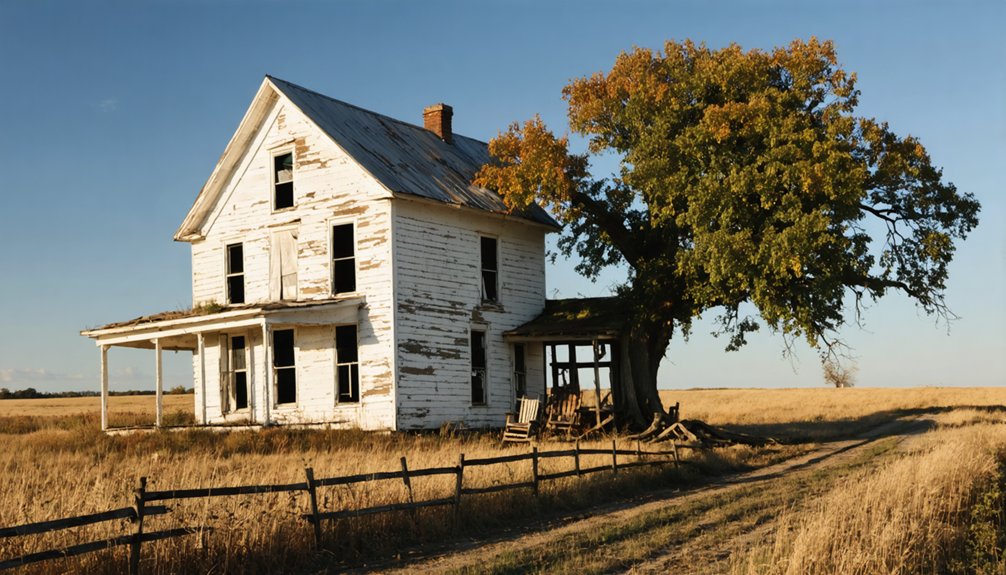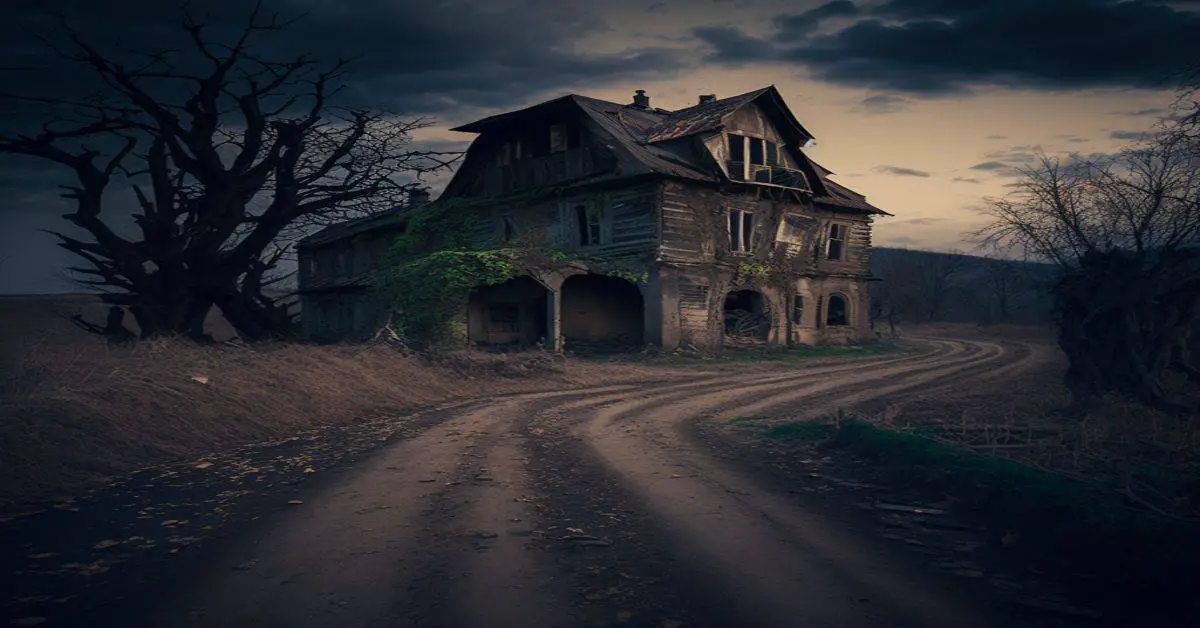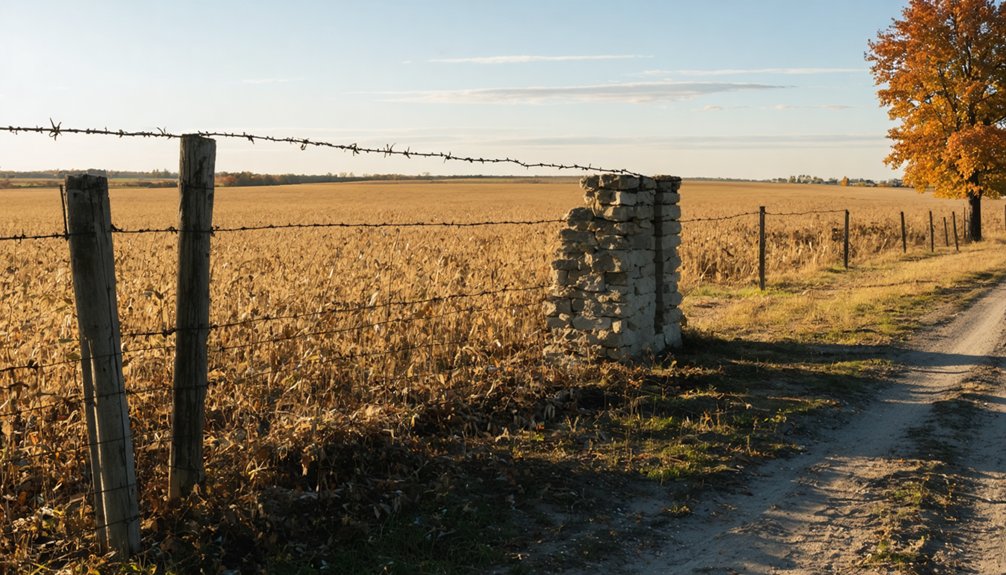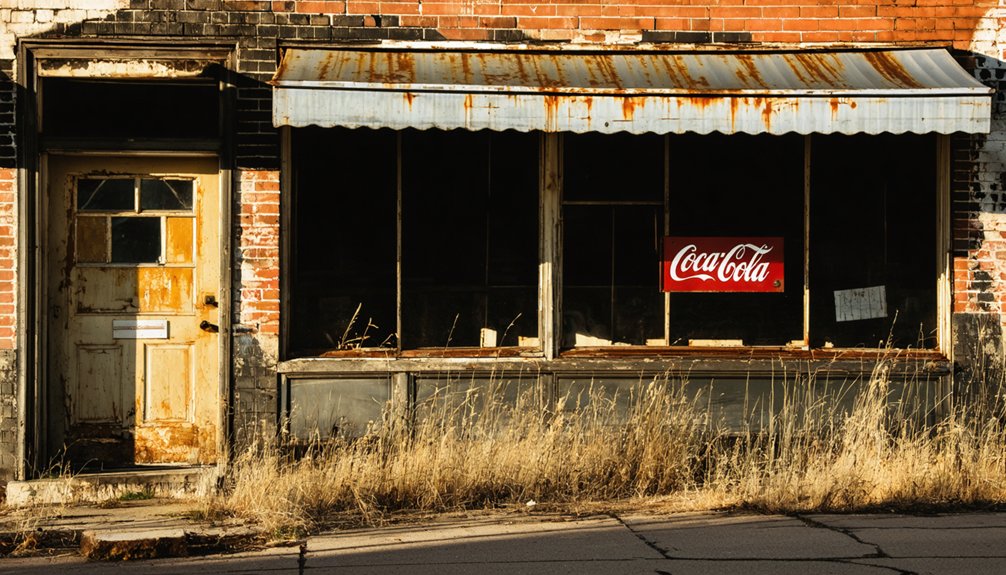Sugarville, Illinois thrived as a coal mining community in the late 1800s, where you’d find a general store, blacksmith shop, and mill serving its close-knit residents near Put Creek. The Southern Gem Coal Company revolutionized local mining through mechanization, employing hundreds and producing over 400,000 tons annually by the 1920s. Today, you’ll find little evidence of this once-bustling town except Moore Cemetery and possibly some rusted machinery beneath privately owned farmland.
Key Takeaways
- Sugarville was a thriving Illinois coal mining town that emerged in the 1800s and became a ghost town by the early 1900s.
- The town’s economy centered around coal mining, with the Southern Gem Coal Company employing hundreds during its peak in the 1920s.
- Sugarville’s decline began when mining jobs disappeared in the late 1800s, causing residents to gradually relocate to larger towns.
- Today, nothing remains of the original structures, with the land now consisting of empty fields and natural growth.
- Moore Cemetery stands as the only significant historical remnant, while buried mining equipment may exist on private agricultural land.
The Rise of a Mining Community
When coal mining began to flourish commercially in Illinois during the early 1800s, the foundation was laid for Sugarville’s emergence as a thriving mining community.
Like many early operations, miners used the room and pillar method to safely extract coal from the underground mines.
You’ll find the town’s true catalyst for growth came in 1871 when the Chicago and Iowa Railroad established its route through the area, opening crucial transportation links for both mining and agriculture.
The early 20th century marked Sugarville’s transformation into an industrial powerhouse.
As the 1900s dawned, Sugarville evolved from humble beginnings into a formidable center of industry and commerce.
Mining technology advanced rapidly, with Modern Coal Company’s Mine No. 1 paving the way for larger operations.
When Southern Gem Coal Company took over in 1919, they revolutionized local mining with mechanization, installing 30 mining machines by 1922.
The community growth exploded as hundreds of miners and their families settled nearby, drawn by steady work and company-provided amenities including housing and shade trees.
Life in Early Sugarville
You’ll find early Sugarville was a close-knit community centered around its general store and blacksmith shop, where residents traded goods and caught up on local news.
Families maintained modest homes near Put Creek, living primarily off farming and local commerce rather than coal mining in the town’s early days. A mill built in 1857 by Joseph H. Gardiner served as a vital economic hub for the settlement.
The social fabric of the town was woven through community gatherings and everyday interactions at local businesses, though specific details of these activities remain limited in historical records.
The town’s later shift to coal mining industry in the late 1800s would dramatically reshape the community’s economic foundation.
Mining Community Daily Life
Life in early Sugarville revolved around three distinct waves of miners and their families: enslaved Black workers in the earliest days, followed by British Isles immigrants, and later Eastern and Southern Europeans who arrived between 1890-1920.
You’d find daily routines centered on grueling 10-12 hour mine shifts, where men and boys as young as 16 worked six days a week.
Women kept the community running through essential work as seamstresses, bakers, and boarding house operators.
Community gatherings helped residents cope with the harsh realities of mining life – frequent accidents, minimal safety protections, and constant economic uncertainty. The inadequate compensation for injuries or deaths left many families destitute. The American Miners’ Association formed in nearby West Belleville to fight for better working conditions.
Families lived in basic shacks, often struggling with hunger and poverty.
Despite these hardships, you’d witness tight-knit bonds forming through shared traditions, mutual support, and collective organizing for better conditions.
Local Business and Trade
Although coal mining dominated Sugarville’s economy, the town sustained a modest but crucial commercial hub centered around its general store and blacksmith shop. Similar to how salt production drove early trade, Sugarville’s commercial activity revolved around its primary resource.
These establishments formed the backbone of local business sustainability, serving both miners and nearby farmers. You’d find the general store stocked with basic provisions, while the blacksmith kept the town’s tools and equipment in working order. Much like the town of Buda, Illinois, Sugarville’s businesses relied heavily on railroad connections for supplies and trade.
Trade relationships with neighboring communities remained limited due to Sugarville’s remote location, forcing the town to rely heavily on local production.
- Basic goods and supplies were available at the general store, a crucial lifeline for residents
- Blacksmith services kept mining operations running by maintaining essential equipment
- Local production helped offset the challenges of limited external trade
- Business activity closely followed the coal industry’s fortunes, ultimately declining as mines closed
Family Social Activities
Despite Sugarville’s remote location and small population, families found diverse ways to maintain vibrant social connections through community gatherings and recreational activities.
You’d find family traditions centered around the local church, which served as the heart of social life, hosting Sunday services, holiday celebrations, and significant life events like weddings and baptisms.
Seasonal festivities included harvest festivals and barn dances, while everyday entertainment consisted of card games, storytelling, and music.
Children played outdoors, engaging in games like tag with neighboring families, while adults participated in quilting or woodworking.
The schoolhouse doubled as a community hub, hosting educational events and youth activities.
When traveling entertainers visited, they’d provide rare but cherished opportunities for the whole community to gather and enjoy performances together.
With a population that classified it as a hamlet size settlement, Sugarville’s intimate community fostered close bonds between its residents.
Economic Backbone and Coal Industry
You’d find Sugarville’s mining operations typical of Southern Illinois coal towns, with the Southern Gem Coal Company No. 2 mine employing hundreds of workers using the room-and-pillar extraction method.
Illinois’ vast bituminous coal reserves made the region an ideal location for mining operations like those in Sugarville.
The mine reached its production zenith in the early 1920s, outputting more than 400,000 tons of coal annually with 30 machines supporting the extraction process.
Underground, miners worked in challenging conditions, creating a network of excavated rooms supported by coal pillars while operating mechanical coal cutters and loading equipment.
The miners’ wages were often diminished by the company store system, which forced workers to purchase goods at inflated prices using company-issued scrip.
Mining Operations and Scale
When mining operations began in Macoupin County in 1867 with the Weer Shaft in Carlinville, it sparked a coal boom that would transform Sugarville and the surrounding region.
You’d find various mining techniques in operation, from traditional shaft mines to more cost-effective strip mining operations where coal seams lay closer to the surface. The Superior Coal Company emerged as a dominant force, establishing massive operations that employed over 1,100 workers at peak production.
- Mines ranged from deep shafts to surface operations, adapting to local geology
- Labor unions fought hard to improve initially low wages and harsh working conditions
- European immigrants brought essential mining expertise to the region’s operations
- Rail infrastructure proved critical for distributing millions of tons of coal annually
Coal Production Peak Years
The Sugarville Coal Company‘s peak production era spanned 1930-1939, yielding 25,334 tons of coal during its relatively brief operational period.
You’ll find that most of the mine’s output occurred between 1930-1938, with 17,911 tons extracted using common production techniques of the era.
Despite the economic challenges of the Great Depression, Sugarville’s operations contributed to Illinois’s position as a leading coal producer. The mine provided essential employment when jobs were scarce, while its coal helped fuel regional industrial growth.
When Yocum and Utzinger took over operations in 1938, they managed to extract an additional 4,623 tons. The final year saw diminished production of 2,800 tons before the mine’s closure in 1939, marking the end of Sugarville’s contribution to Illinois’s vast bituminous coal industry.
Worker Life Underground
Deep beneath Illinois’s surface, Sugarville’s miners faced grueling conditions as they extracted coal using the room and pillar method throughout the 1930s.
You’d find workers confronting numerous mining hazards while leaving strategic pillars of coal to prevent cave-ins. Despite mechanization efforts, the fight for miner rights remained constant as laborers, including young workers under 16, toiled in dangerous environments with minimal safety measures.
- Immigrant miners brought specialized skills like carpentry and blacksmithing to improve underground operations.
- Families supported union organizing efforts to combat hazardous working conditions.
- Children worked alongside adults until labor reforms took effect.
- The introduction of machines like those used in Southern Gem mines gradually improved efficiency, though dangers persisted.
The Exodus and Abandonment
As jobs vanished from Sugarville’s failing coal mines in the late 1800s, residents began a steady exodus that would ultimately transform the once-thriving settlement into a ghost town.
Unlike some Illinois ghost towns that succumbed to sudden disasters or railroad relocations, Sugarville’s decline followed predictable outmigration patterns as families sought opportunities elsewhere.
You’ll find no record of organized relocation efforts or mass resettlements. Instead, individual families made their own choices to leave, accelerating through the 1890s as the town’s social disintegration became inevitable.
By the turn of the century, most residents had scattered to larger towns and cities offering more diverse employment.
What remained was a quiet reflection of the vulnerability of single-industry communities in an evolving economic landscape.
What Remains Today
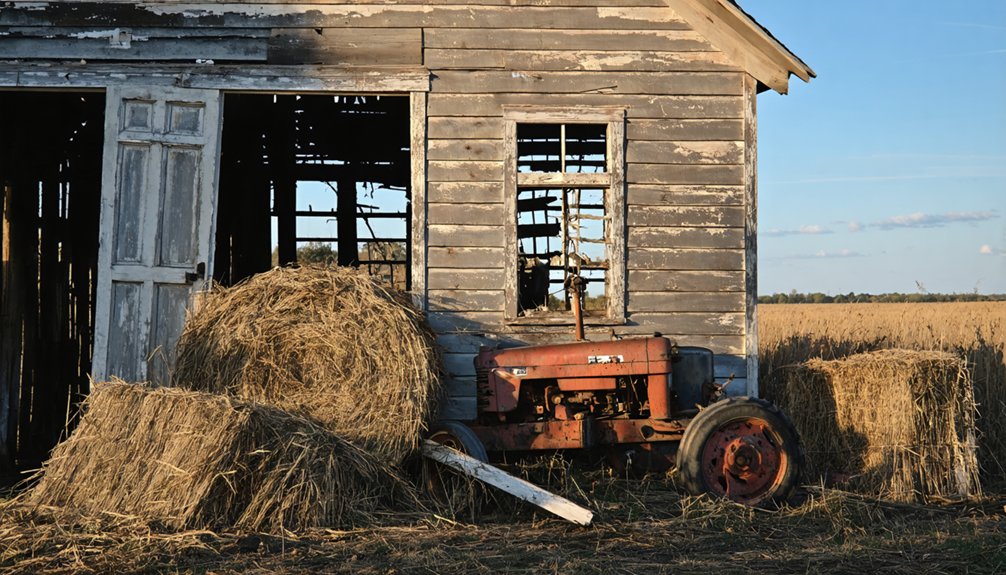
Visitors searching for remnants of Sugarville today will find little more than empty fields and natural growth where this once-bustling coal mining town stood.
Archaeological findings are sparse, with no original structures remaining on the site. The area has largely reverted to farmland, with Put Creek still meandering through the rural landscape as it did in Sugarville’s heyday.
Time has erased Sugarville’s physical presence, leaving only Put Creek winding through farmland where a town once thrived.
- Moore Cemetery stands as the most prominent historical remnant, offering the only tangible connection to the former settlement.
- You won’t find any marked ruins or restored buildings to identify the town’s original footprint.
- Scattered pieces of rusted machinery and mining equipment may still lie beneath the soil.
- The land remains privately owned, primarily used for agriculture, with no public historical displays or monuments.
Legacy of a Lost Town
While Sugarville’s physical structures have vanished into Illinois farmland, the town’s historical significance endures as a reflection of America’s industrial past.
You’ll find Sugarville’s story preserved in regional archives and historical records, documenting its rise and fall as a coal mining settlement that once bustled with life along Put Creek.
The town’s legacy lives on through local historical accounts, serving as a poignant reminder of how single-industry communities faced devastating challenges during economic shifts.
Community nostalgia persists in tales of the general store, blacksmith shop, and close-knit mining families who called Sugarville home.
Today, the ghost town stands as a symbol to broader patterns of rural decline and urbanization that reshaped Illinois’s landscape during the industrial age.
Frequently Asked Questions
Are There Any Paranormal or Supernatural Stories Associated With Sugarville’s Ruins?
You’d think ghost sightings would involve dramatic specters, but Sugarville’s haunted locations feature subtler paranormal activity – phantom touches on your feet, unexplained body tingles, invisible pushes, and mysteriously activated lights.
What Happened to the Cemetery and Burial Grounds of Sugarville Residents?
You’ll find few records remain of the cemetery’s exact fate. Burial ground history suggests it likely became overgrown and forgotten, like many abandoned town cemeteries, with preservation efforts hindered by private land restrictions.
Can Visitors Legally Explore the Remaining Ruins of Sugarville Today?
Like other forbidden fruit, you can’t legally explore Sugarville’s ruins without proper permission. Current visitor regulations require landowner consent, and exploration guidelines prohibit unauthorized access to these privately-owned remains.
Were There Any Notable Crimes or Accidents in Sugarville’s Mining History?
You won’t find reliable records of mining accidents or crime reports from Sugarville, as there’s no documented evidence of this location’s existence in Illinois mining or criminal history.
Did Any Famous or Historically Significant People Come From Sugarville?
Like a town without footprints in history’s sand, you won’t find any famous residents or historical figures from Sugarville. Records show no prominent individuals emerged from this short-lived mining community.
References
- https://illinoisstateonline.com/ghost-towns-in-illinois/
- https://www.sugargroveil.gov/history-of-sugar-grove
- http://cantontornado36.blogspot.com/2017/04/ghost-towns-of-fulton-county-illinois.html
- https://www.youtube.com/watch?v=fy3yJDBA5nI
- https://drloihjournal.blogspot.com/2022/09/lost-towns-of-illinois-sugarville.html
- https://drloihjournal.blogspot.com/p/lost-towns-of-illinois-series.html
- https://storymaps.arcgis.com/stories/6ea7c4b9b0594c039c2792d5be7456c9
- https://savingplaces.org/guides/ghost-towns-on-route-66
- https://en.wikipedia.org/wiki/List_of_ghost_towns_in_Illinois
- http://www.illinoisarchaeology.com/IDNR/Coal Mines/Interstate Coal Company Mine ASSR 2.pdf
